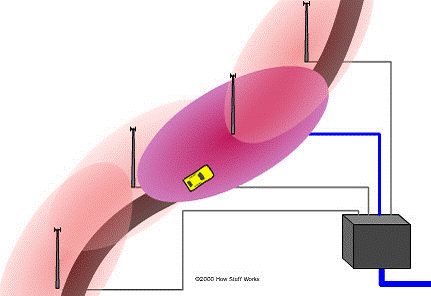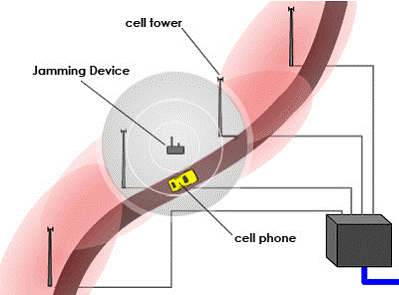





Published on Apr 02, 2024
A GSM Jammer or cell phone jammer is a device that transmit signal on the same frequency at which the GSM system operates, the jamsming success when the mobile phones in the area where the jammer is located are disabled.
Communication jamming devices were first developed and used by military. Where tactical commanders use RF communications to exercise control of their forces, an enemy has interest in those communications. This interest comes from the fundamental area of denying the successful transport of the information from the sender to the receiver.
Nowadays the mobile jammer devices or cell phone jammer software are becoming civilian products rather than electronic warfare devices, since with the increasing number of the mobile phone users the need to disable mobile phones in specific places where the ringing of cell phone would be disruptive has increased. These places include worship places, university lecture rooms, libraries, concert halls, meeting rooms, and other places where silence is appreciated
Jamming devices overpower the cell phone by transmitting a signal on the same frequency as the cell phone and at a high enough power that the two signals collide and cancel each other out. Cell phones are designed to add power if they experience low-level interference, so the jammer must recognize and match the power increase from the phone. Cell phones are full-duplex devices, which mean they use two separate frequencies, one for talking and one for listening simultaneously. Some jammers block only one of the frequencies used by cell phones, which has the effect of blocking both.
The phone is tricked into thinking there is no service because it can receive only one of the frequencies. Less complex devices block only one group of frequencies, while sophisticated jammers can block several types of networks at once to head off dual-mode or tri-mode phones that automatically switch among different network types to find an open signal. Some of the high-end devices block all frequencies at once and others can be tuned to specific frequencies.
To jam a cell phone, all you need is a device that broadcasts on the correct frequencies. Although different cellular systems process signals differently, all cell-phone networks use radio signals that can be interrupted. GSM, used in digital cellular and PCS-based systems, operates in the 900-MHz and 1800-MHz bands in Europe and Asia and in the 1900-MHz (sometimes referred to as 1.9-GHz) band in the United States. Jammers can broadcast on any frequency and are effective against AMPS, CDMA, TDMA, GSM, PCS, DCS, iDEN and Nextel systems. Old-fashioned analog cell phones and today's digital devices are equally susceptible to jamming. Disrupting a cell phone is the same as jamming any other type of radio communication. A cell phone works by communicating with its service network through a cell tower or base station. Cell towers divide a city into small areas, or cells. As a cell phone user drives down the street, the signal is handed from tower to tower


A jamming device transmits on the same radio frequencies as the cell phone, disrupting the communication between the phone and the cell-phone base station in the town
It's a called a denial-of-service attack . The jammer denies service of the radio spectrum to the cell-phone users within range of the jamming device. Older jammers sometimes were
limited to working on phones using only analog or older digital mobile phone standards. Newer models such as the double and triple band jammers can block all widely used systems (AMPS, iDEN, GSM, etc) and are even very effective against newer phones which hop to different frequencies and systems when interfered with. As the dominant network technology and frequencies used for mobile phones vary worldwide, some work only in specific regions such as Europe or North America.
The power of the jammer's effect can vary widely based on factors such as proximity to towers, indoor and outdoor settings, presence of buildings and landscape, even temperature and humidity play a role. There are concerns that crudely designed jammers may disrupt the functioning of medical devices such as pacemakers. However, like cell phones, most of the devices in common use operate at low enough power output (<1W) to avoid causing any problems
In this device we overpower cell phone's signal with a stronger signal, This type of device comes equipped with several independent oscillators transmitting 'jamming signals' capable of blocking frequencies used by paging devices as well as those used by cellular/PCS systems' control channels for call establishment. When active in a designated area, such devices will (by means of RF interference) prevent all pagers and mobile phones located in that area from receiving and transmitting calls. This type of device transmits only a jamming signal and has very poor frequency selectivity, which leads to interference with a larger amount of communication spectrum than it was originally intended to target. Technologist Jim Mahan said, "There are two types. One is called brute force jamming, which just blocks everything. The problem is, it's like power-washing the airwaves and it bleeds over into the public broadcast area. The other puts out a small amount of interference, and you could potentially confine it within a single cell block. You could use lots of little pockets of small jamming to keep a facility under control."
Unlike jammers, Type "B" devices do not transmit an interfering signal on the control channels. The device, when located in a designated 'quiet' area, functions as a 'detector'. It has a unique identification number for communicating with the cellular base station. When a Type "B" device detects the presence of a mobile phone in the quiet room; the 'filtering' (i.e. the prevention of authorization of call establishment) is done by the software at the base station.
When the base station sends the signaling transmission to a target user, the device after detecting simultaneously the presence of that signal and the presence of the target user, signals the base station that the target user is in a 'quiet' room; therefore, do not establish the communication. Messages can be routed to the user's voice- mail box, if the user subscribes to a voice-mail service. This process of detection and interruption of call establishment is done during the interval normally reserved for signaling and handshaking. For 'emergency users', the intelligent detector device makes provisions for designated users who have emergency status. These users must pre-register their phone numbers with the service providers. When an incoming call arrives, the detector recognizes that number and the call are established for a specified maximum duration, say two minutes. The emergency users are also allowed to make out going calls. Similarly, the system is capable of recognizing and allowing all emergency calls routed to "911".
It should be noted that the Type "B" detector device being an integral part of the cellular/PCS systems, would need to be provisioned by the cellular/PCS service providers or provisioned by a third-party working cooperatively with full support of the cellular/PCS service providers
Unlike jammers, Type “C” devices do not transmit an interfering signal on the control channels. The device, when located in a designated ‘quiet’ area, functions as a ‘beacon’ and any compatible terminal is instructed to disable its ringer or disable its operation, while within the coverage area of the beacon. Only terminals which have a compatible receiver would respond and this would typically be built on a separate technology from cellular/PCS, e.g., cordless wireless, paging, ISM, Bluetooth. On leaving the coverage area of the beacon, the handset must re-enable its normal function.
This technology does not cause interference and does not require any changes to existing PCS/cellular operators. The technology does require intelligent handsets with a separate receiver for the beacon system from the cellular/PCS receiver. It will not prevent normal operation for incompatible legacy terminals within a “quiet” coverage area, thus effective deployment will be problematic for many years.
While general uninformed users would lose functionality, pre-designated “emergency” users could be informed of a “bypass terminal key sequence” to inhibit response to the beacon. Assuming the beacon system uses a technology with its own license (or in the license exempt band), no change to the regulations are needed to deploy such a system. With this system, it would be extremely difficult to police misuse of the “bypass key sequence” by users.
This jammer behaves like a small, independent and portable base station, which can directly interact intelligently or unintelligently with the operation of the local mobile phone. The jammer is predominantly in receiving mode and will intelligently choose to interact and block the cell phone directly if it is within close proximity of the jammer.
This selective jamming technique uses a discriminating receiver to target the jamming transmitter. The benefit of such targeting selectivity is much less electromagnetic pollution in terms of raw power transmitted and frequency spectrum from the jammer, and therefore much less disruptive to passing traffic. The jam signal would only stay on as long as the mobile continues to make a link with the base station, otherwise there would be no jamming transmission – the technique forces the link to break or unhook and then it retreats to a passive receive mode again.
This technique could be implemented without cooperation from PCS/cellular providers, but Could negatively impact PCS/cellular system operation. This technique has an added advantage over Type B in that no added overhead time or effort is spent negotiating with the cellular network. As well as Type B, this device could discriminate 911 calls and allow for breakthroughs” during emergencies.
This technique is using EMI suppression techniques to make a room into what is called a Faraday cage. Although labor intensive to construct, the Faraday cage essentially blocks, or greatly attenuates, virtually all electromagnetic radiation from entering or leaving the cage – or in this case a target room.
With current advances in EMI shielding techniques and commercially available products one could conceivably implement this into the architecture of newly designed buildings for so-called “quiet-conference” rooms. Emergency calls would be blocked unless there was a way to receive and decode the 911 transmissions, pass by coax outside the room and re-transmitted.
This passive configuration is currently legal in Canada for any commercial or residential location insofar as DOC Industry Canada is concerned, however municipal or provincial building code by- laws may or may not allow this type of construction.
This project is mainly intended to prevent the usage of mobile phones in places inside its coverage without interfering with the communication channels outside its range, thus providing a cheap and reliable method for blocking mobile communication in the required restricted areas only.
Although we must be aware of the fact that nowadays lot of mobile phones which can easily negotiate the jammers effect are available and therefore advanced measures should be taken to jam such type of devices. These jammers includes the intelligent jammers which directly communicates with the GSM provider to block the services to the clients in the restricted areas,but we need the support from the providers for this purpose.
| Are you interested in this topic.Then mail to us immediately to get the full report.
email :- contactv2@gmail.com |